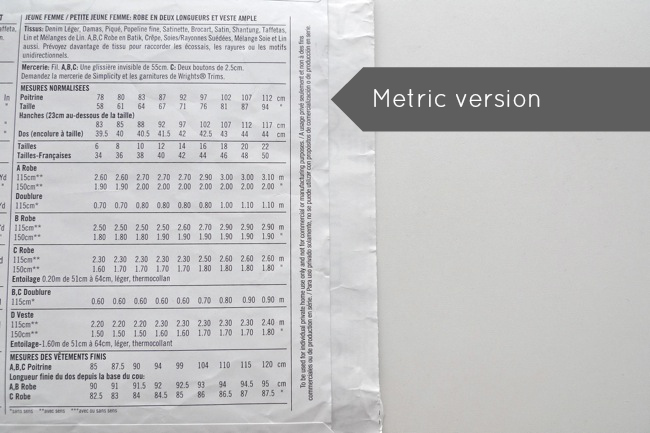
Update: This post was written in early 2013 to help makers decipher the information on the envelopes of sewing patterns by the largest brands (Simplicity, McCalls, Vogue, Butterick, Burda...). Since then, many independent pattern companies - including my own! - have come onto the market offering more beginner-friendly patterns. Depending on the brand, some of this post will also be relevant to indie patterns, while some of it will only be relevant to the bigger companies.
So - you’ve got your first sewing pattern and are ready to make that garment. But what on Earth does all that stuff on the envelope mean?! Navigating and deciphering the text on a sewing pattern cover for the first time can make your eyes glaze over and your brain ache. A whole load of information is crammed into a small space, numbers jumping all over the place.
No need to fear though! It's easy to understand sewing pattern envelopes once you get to grips with them. Let's break it down…

Front cover
Pattern number → Most patterns have numbers which act as a product identification code to help you find a particular pattern. Smaller indie companies often give their patterns names too.
Size → While vintage patterns are often one size only, modern patterns tend to come nested in multiple sizes, allowing you to mix and match your measurements. Do still pay attention to this part though, as some companies sell two or more versions of a pattern in different size brackets.
Design variations → While some patterns are for one fixed design only, many offer a few different style options. The pattern illustrated above, for example, includes different necklines, hem length, sleeves, waistline tabs, and even a jacket.
Pattern envelopes also include photos, graphic illustrations, or sometimes both, for each design. Use your imagination here to picture the garment on your own body in a fabric of your choosing.

Back cover
Fabric suggestions → This will give you an idea of the kinds of fabrics that will suit the garment. It isn't a definitive list - go ahead and pick something off list which is similar in weight, drape etc to the fabrics listed. Just beware using knit fabrics (eg. jersey) for patterns suggesting only woven fabrics (eg. cotton, wool etc) and vice versa, as stretch can alter the shape and size of the garment.
Notions will be listed here too - the additional bits and bobs to put on your shopping list, such as the number and size of any buttons, the length of zipper etc. (Don’t forget to buy thread too!)
Body measurements → These numbers refer to the size of the body that the pattern is to fit, in inches (see below for cm). The measurements included are usually bust (around the fullest part), waist, hip and length of torso. Does your bust, hip and waist ratio match one of these columns exactly? Lucky you! Most of us, however, have larger bits and smaller bits, so will need to combine different sizes (eg. size 12 bust and waist with size 14 hip, or whatever). (We’ll look at fitting in more detail in a separate post.)
Pattern size → The pattern size is usually listed either in numbers which are supposed to correspond to ready-to-wear dress sizes (8/10/12 etc) or sometimes in S/M/L. Personally I consider these a red herring, as those sizes mean totally different things to different people. I prefer to pay close attention to body measurements (above) to pick out the pattern (or combination) that fits me.
Fabric requirements → This refers to the length of fabric that you need, in yards, to make the garment (see below for metres). Once you've picked your pattern size (based on your body measurements), follow the column down to the corresponding fabric requirement listing. Often the pattern will give you a couple of different fabric widths (eg. 45" / 60"), as the size of fabric rolls varies. If a pattern includes design variations, it may list different requirements for those two. The lengths given are often generous (sometimes ridiculously so), so sometimes you can get away with less – but do check the pattern layout first.
Sometimes a pattern will list a different yardage for fabrics with nap. Fabrics with “nap” are types such as corduroy and velvet - they have pile lying in a particular direction which looks slightly different from different angles. They often require more fabric to make sure the lay of the pile is all going in the same direction when you stitch the garment together. The same applies to fabrics with snazzy designs going in one direction only.
If you need interfacing and/or lining fabric, the pattern will list these too.
Garment measurements → These numbers refer to measurements of parts of the finished garment. These are sometimes printed in more detail on the pattern pieces too. Garment measurements are usually bigger than body measurements, even if it's a fitted garment, to account for "ease" to allow you to move around in it. It’s useful to compare the two, as ease varies between different pattern companies - subtract the body measurements from the garment measurements to work out the ease allowance. You may want to change the ease allowance for a closer or looser fit, depending on your preference. (We'll look at ease in more detail in a separate post.)

Metric version → Many sewing patterns present all this information in French as well as English. This is actually really useful for anglophones who uses the metric system of measurements. Body measurements are presented in cm and fabric requirements in metres, rather than inches and yards. (Some indie pattern companies helpfully list both.)
See? That wasn't so bad after all!
Although it is a LOT of information to digest, so I'll go into the inside of a pattern in another post if you would find that helpful.
Liked this? Read other posts in the Learn to Sew series.
